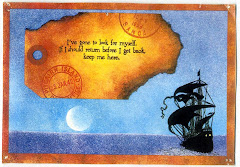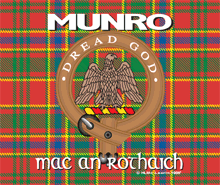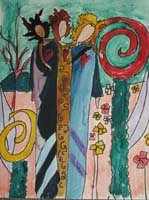"LISBETH READING" by Carl Larsson
(A huge Christmas Cactus brightens a
Swedish room in winter)
Many plants have come to be associated with Christmas, and since most of them have beautiful coloring, they bring us much joy in December and other dark months. Many of them have also become associated with Christmas lore and legend, mostly Christian but some pagan as well.
"POINSETTIA - FIDDLERS THREE"
by Patricia A. Hicks Ruiz
Legend has it that a poor young girl in Mexico was on her way to Christmas Eve mass. She had nothing to bring to the Christ child. So, she picked some green plants along the side of the road. When she arrived at the church, the plants had burst into beautiful red blooms. You guessed it. She was carrying poinsettias. In the 1800s, U.S. Ambassador John Poinsett brought the plants back with him to the U.S. He gave the plants, which would come to be named after him, as gifts to family and friends.
1986 12 Pence Stamp, Great Britain
The Glastonbury Thorn legend ties in with Christ's death as well as the celebration of his birth. The legend goes that soon after the death of Christ, Joseph of Arimathea came to Britain to spread the message of Christianity. When he traveled there from the Holy Land he brought with him his staff. Being tired from his journey, he lay down to rest. In doing so, he pushed his staff into the ground beside him. When he awoke, he found that the staff had taken root and begun to grow and blossom. It is said he left it there and it has flowered every Christmas and every spring. Supposedly the Queen of England has a sprig of Glastonbury Thorn by her plate at Christmas dinner at Buckinham Palace.
"MISTLETOE" by Brian Cunningham
The Druids believed the mistletoe's magickal properties extended beyond fertility. It was believed to cure almost any disease and was known as the all healer. Sprigs fixed above doorways of homes were said to keep away lightning and other types of evil. Because the plant has no roots it was believed that it grew from heaven. Five days after the New Moon of Yule, Druid priests would cut mistletoe from the sacred oak with a sickle made of gold. The branches were divided into sprigs and given to people to hang over their doorways for protection. Mistletoe was placed in baby cradles to protect them from faeries.
The custom of kissing under the mistletoe came from Norse legend. Frigga, goddess of love and beauty, had a son, Balder, beloved by all. She wanted nothing to harm him and went through the earth getting all that sprang from the four elements, fire, water, air and earth, so that he would be safe. The goddess overlooked the mistletoe.
Loki, god of evil, wanted to hurt Balder, so, knowing Frigga neglected to ask the mistletoe not to harm Balder, he made an arrow from its wood, then took it to Hoder, Balder’s blind brother, guided his hand and shot the arrow into Balder’s heart. The boy died.
All living creatures tried to bring Balder back to life for three days to no avail. Finally Frigga managed to revive her son with the help of the mistletoe. Her tears on the plant became white berries and she blessed the plant. Anyone who stands under the mistletoe plant would never be hurt and was entitled to a kiss, a token of love.
"RED AMARYLLIS" by Altair Leal
The amaryllis is another plant linked with Christmas that has pagan origins - this time, in Greek mythology. Legend has it that the amaryllis began as a shy, timid nymph. Amaryllis fell deeply in love with Alteo, a shepherd with Hercules' strength and Apollo's beauty, but her affections were unrequited. Hoping that she could win him over by bestowing upon him the thing he desired most - a flower so unique it had never existed in the world before - Amaryllis sought advice from the Oracle of Delphi.
Following the Oracle's instructions, Amaryllis dressed in maiden's white and appeared at Alteo's door for 30 nights, each time piercing her heart with a golden arrow. When at last Alteo opened his door, there before him was a striking crimson flower, sprung from the blood of Amaryllis's heart.
Following the Oracle's instructions, Amaryllis dressed in maiden's white and appeared at Alteo's door for 30 nights, each time piercing her heart with a golden arrow. When at last Alteo opened his door, there before him was a striking crimson flower, sprung from the blood of Amaryllis's heart.
"ROSEMARY WREATH" by Teri Casper
Several common herbs have legends connected with the Holy Family's flight to Egypt after Jesus was born. Since rosemary is silent underfoot, its soft leaves muffling crackling twigs beneath it, it prevented detection and ensured their safe journey.
Another story involves rosemary, sugar cane and date palm. The plants argued as to which provided the Holy Family with the greatest benefit. Palm sheltered them in the daytime heat and gave them fruit. Sugar cane provided sweetness. The rosemary bush was silent, having nothing special to offer the family.
After Mary washed Jesus' swaddling clothes she asked the palm to bend its head so she could hang them on its fronds to dry. It couldn’t bend low enough for her to reach them. Sugar cane offered its branches but the clothes fell to the ground. So Mary hung out Jesus' clothes on the rosemary, a small flowerless bush that had antiseptic properties. Mary blessed the rosemary, giving it flowers the blue color of her robe. Legend has it that a rosemary plant will grow no higher than six feet in thirty-three years, so as not to stand taller than Jesus did.
During their flight to Egypt, Mary, Jesus and Joseph ran out of water. Joseph went to the nearest village to get some. Mary heard Herod's soldiers’ shouts and the sound of hoof beats approaching. There was no place to hide.
Mary saw a rose bush and asked for shelter. It refused, which is why rose bushes have thorns. The clove bush also refused help and this resulted in it having unpleasant smelling flowers. The sage plant hid them, blossoming to create safe haven. The soldiers passed by. Since then, the plant was considered sacred and believed to possess curative and protective powers.
SNOWDROPS AND HOLLY by Jill Bonner
Although the snowdrop is most commonly associated with very early spring, it is sometimes thought of as a Christmas plant. A legend about the origin of the snowdrop tells us that after being expelled from the Garden of Eden, Eve sat weeping. An angel comforted her. Since the Fall, no flowers had bloomed, and snow fell ceaselessly. As the angel talked with Eve, he caught a snowflake in his hand, breathed on it, and it fell to earth as the first snowdrop. The flower bloomed and Hope was born.
In Germany there is a different snowdrop legend. When God made all things on the Earth, He asked the snow to go to the flowers and get a little color from them. One by one the flowers refused. Then, very sad, the snow asked a snowdrop to give it a little of its colour and the snowdrop accepted. As a reward, the snow lets it bloom first whenever spring shows.
"CHRISTMAS CACTUS" by Margaret Mackay
"CHRISTMAS ROSE (Victorian print)
I love the The Legend of the Christmas Rose, a flower (helleborus niger) common in the British Isles but not here. It tells of a young girl named Madelon who wanted to go worship the Christ Child. Seeing the gold, frankincense and myrrh brought by others who were drawn to the humble birthplace, she despaired that she had no gift to bring, for Madelon was poor indeed.
"Nor myrrh, nor frankincense, nor gold," said the angel, "is offering more meet for the Christ Child than these pure Christmas Roses." And thus young Madelon went her way and worshipped the Prince of Peace, bearing the gift of her heart and tears.
"HOLLY AND IVY" by Maggi Kirkland
And then you have the Holly and the Ivy, perhaps the most famous Christmas plants of all. There's so much information on these two plants that I am going to devote an entire post to them.









































10 comments:
Some great little stories. I love these Christmas tales. Thank you for posting them for us.
Mary
Again - a fabulous lesson for us - makes the plants much more personal - thanks for sharing your knowledge.
Once again, you've made it a pleasure to learn:-)
Nice blog. I really like all the paintings of flowers on your blog. They looks awesome. Enjoyed your blog very much.
I love visiting your blog, Julie. Always a wealth of information that is charming to read (and I hope some of it sticks too!) and so very interesting. I always love your photos too; the art work is exquisite!
Great blog post about the xmas tales. Thank you for being so informative and your writing is wonderful. Blessed be.
Thanks for posting that :-)
Never heard the history of the Red Amaryllis which is a favorite of mine. Such a big beautiful blossom and it blooms again and again.
Thanks dear Julie for sharing all that you do.
xx
Julie, you share so much, some I knew, but not all. And you tell it so well. I am starting to think of you as the Christmas lady. A world of knowledge in you, and you search a answer.
Think of you on this slushy day..the rain has messed up our beautiful snow.
Love, Mary
Thank you, thank you Julie for these wondrous Christmas tales, all so interesting. The paintings are beautiful.
The Glastonbry Thorn I'm really interested in because is reminds me of my favorite song "Jerusalem" (I seem to recall you love it too!) where "and did those feel in ancient time, walk upon England's mountains green.....etc." refer to this. That song is one of the first English schoolchildren learn to sing....and it is beautiful!!!!
Post a Comment